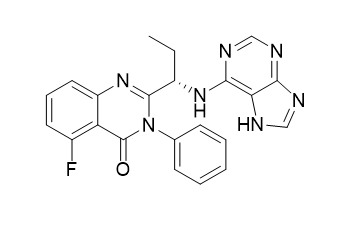Idelalisib (CAL-101)
Idelalisib (CAL-101, GS-1101) is a selective p110δ inhibitor with IC50 of 2.5 nM in cell-free assays; shown to have 40- to 300-fold greater selectivity for p110δ than p110α/β/γ, and 400- to 4000-fold more selectivity to p110δ than C2β, hVPS34, DNA-PK and mTOR. Idelalisib also stimulates autophagy.
Inquire / Order:
manager@chemfaces.com
Technical Inquiries:
service@chemfaces.com
Tel:
+86-27-84237783
Fax:
+86-27-84254680
Address:
1 Building, No. 83, CheCheng Rd., Wuhan Economic and Technological Development Zone, Wuhan, Hubei 430056, PRC
Providing storage is as stated on the product vial and the vial is kept tightly sealed, the product can be stored for up to
24 months(2-8C).
Wherever possible, you should prepare and use solutions on the same day. However, if you need to make up stock solutions in advance, we recommend that you store the solution as aliquots in tightly sealed vials at -20C. Generally, these will be useable for up to two weeks. Before use, and prior to opening the vial we recommend that you allow your product to equilibrate to room temperature for at least 1 hour.
Need more advice on solubility, usage and handling? Please email to: service@chemfaces.com
The packaging of the product may have turned upside down during transportation, resulting in the natural compounds adhering to the neck or cap of the vial. take the vial out of its packaging and gently shake to let the compounds fall to the bottom of the vial. for liquid products, centrifuge at 200-500 RPM to gather the liquid at the bottom of the vial. try to avoid loss or contamination during handling.
Horticulturae2021, 7(1),5.
Molecules.2024, 29(5):1050.
Cells.2023, 12(1):168.
J Breast Cancer.2015, 18(2):112-118
Eur J Pharmacol.2024, 975:176644.
Life Sci.2023, 332:122107.
Iranian Journal of Pharmaceutical Sciences2021, 17(2):25-36
Sains Malaysiana2024, 53(2):397-408.
Allergol Immunopathol (Madr).2022, 1;50(4):23-30.
Molecules.2024, 29(23):5632.
Related and Featured Products
Blood,2011 Jan 13;117(2):591-4.
CAL-101, a p110delta selective phosphatidylinositol-3-kinase inhibitor for the treatment of B-cell malignancies, inhibits PI3K signaling and cellular viability.[Pubmed:
20959606]
Phosphatidylinositol-3-kinase p110δ serves as a central integration point for signaling from cell surface receptors known to promote malignant B-cell proliferation and survival. This provides a rationale for the development of small molecule inhibitors that selectively target p110δ as a treatment approach for patients with B-cell malignancies.
METHODS AND RESULTS:
We thus identified 5-fluoro-3-phenyl-2-[(S)-1-(9H-purin-6-ylamino)-propyl]-3H-quinazolin-4-one (CAL-101), a highly selective and potent p110δ small molecule inhibitor (half-maximal effective concentration [EC(50)] = 8nM). Using tumor cell lines and primary patient samples representing multiple B-cell malignancies, we have demonstrated that constitutive phosphatidylinositol-3-kinase pathway activation is p110δ-dependent. CAL-101 blocked constitutive phosphatidylinositol-3-kinase signaling, resulting in decreased phosphorylation of Akt and other downstream effectors, an increase in poly(ADP-ribose) polymerase and caspase cleavage and an induction of apoptosis.
CONCLUSIONS:
These effects have been observed across a broad range of immature and mature B-cell malignancies, thereby providing a rationale for the ongoing clinical evaluation of CAL-101.
Blood,2012 Feb 23;119(8):1897-900.
PI3Kδ inhibitor, GS-1101 (CAL-101), attenuates pathway signaling, induces apoptosis, and overcomes signals from the microenvironment in cellular models of Hodgkin lymphoma.[Pubmed:
22210877]
GS-1101 (CAL-101) is an oral PI3Kδ-specific inhibitor that has shown preclinical and clinical activity in non-Hodgkin lymphoma and chronic lymphocytic leukemia.
METHODS AND RESULTS:
To investigate the potential role of PI3Kδ in Hodgkin lymphoma (HL), we screened 5 HL cell lines and primary samples from patients with HL for PI3Kδ isoform expression and constitutive PI3K pathway activation. Inhibition of PI3Kδ by GS-1101 resulted in the inhibition of Akt phosphorylation. Cocultures with stroma cells induced Akt activation in HL cells, and this effect was blocked by GS-1101. Conversely, production of the stroma-stimulating chemokine, CCL5, by HL cells was reduced by GS-1101. GS-1101 also induced dose-dependent apoptosis of HL cells at 48 hours. Reductions in cell viability and apoptosis were enhanced when combining GS-1101 with the mTOR inhibitor everolimus.
CONCLUSIONS:
Our findings suggest that excessive PI3Kδ activity is characteristic in HL and support clinical evaluation of GS-1101, alone and in combination, as targeted therapy for HL.
Blood,2010 Sep 23;116(12):2078-88.
Phosphatidylinositol 3-kinase-δ inhibitor CAL-101 shows promising preclinical activity in chronic lymphocytic leukemia by antagonizing intrinsic and extrinsic cellular survival signals.[Pubmed:
20522708]
Cell lines:CLL B cells or healthy volunteer T cells or NK cells
Concentrations: 0.01-100 μM
Incubation Time: 48 hours
Method:
MTT assays are performed to determine cytotoxicity. 1 × 105 cells are incubated with CAL-101. MTT reagent is then added, and plates are incubated for an additional 20 hours before washing with protamine sulfate in phosphate-buffered saline. DMSO is added, and absorbance is measured by spectrophotometry at 540 nm in a Labsystems plate reader. Cell viability is also measured at various time points with the use of annexin/PI flow cytometry. Data are analyzed. At least 104 cells are counted for each sample. Results are expressed as the percentage of total positive cells over untreated control. Experiments examining caspase-dependent apoptosis included the addition of 100 μM Z-VAD. Experiments examining survival signals include the addition of 1 μg/mL CD40L, 800 U/mL IL-4, 50 ng/mL BAFF, 20 ng/mL TNF-α, or coculturing on fibronectin or stromal (HS-5 cell line) coated plates. Stromal coculture is done by plating a 75-cm2 flask (80%-100% confluent) per 6-well plate 24 hours before the addition of CLL cells.



